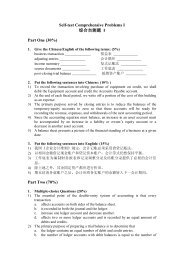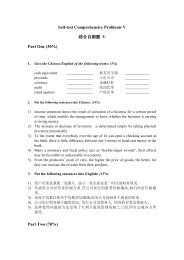Vodafone Group Plc Annual Report for the year ended 31 March 2012
Vodafone Group Plc Annual Report for the year ended 31 March 2012
Vodafone Group Plc Annual Report for the year ended 31 March 2012
You also want an ePaper? Increase the reach of your titles
YUMPU automatically turns print PDFs into web optimized ePapers that Google loves.
Critical accounting estimates<br />
<strong>Vodafone</strong> <strong>Group</strong> <strong>Plc</strong><br />
<strong>Annual</strong> <strong>Report</strong> <strong>2012</strong><br />
91<br />
The <strong>Group</strong> prepares its consolidated financial statements in accordance<br />
with IFRS as issued by <strong>the</strong> IASB and IFRS as adopted by <strong>the</strong> EU,<br />
<strong>the</strong> application of which often requires judgements to be made by<br />
management when <strong>for</strong>mulating <strong>the</strong> <strong>Group</strong>’s financial position and<br />
results. Under IFRS, <strong>the</strong> directors are required to adopt those accounting<br />
policies most appropriate to <strong>the</strong> <strong>Group</strong>’s circumstances <strong>for</strong> <strong>the</strong> purpose<br />
of presenting fairly <strong>the</strong> <strong>Group</strong>’s financial position, financial per<strong>for</strong>mance<br />
and cash flows.<br />
In determining and applying accounting policies, judgement is often<br />
required in respect of items where <strong>the</strong> choice of specific policy,<br />
accounting estimate or assumption to be followed could materially<br />
affect <strong>the</strong> reported results or net asset position of <strong>the</strong> <strong>Group</strong> should it<br />
later be determined that a different choice would be more appropriate.<br />
Management considers <strong>the</strong> accounting estimates and assumptions<br />
discussed below to be its critical accounting estimates and, accordingly,<br />
provides an explanation of each below.<br />
The discussion below should also be read in conjunction with <strong>the</strong><br />
<strong>Group</strong>’s disclosure of significant IFRS accounting policies which is<br />
provided in note 2 to <strong>the</strong> consolidated financial statements, “Significant<br />
accounting policies”.<br />
Management has discussed its critical accounting estimates and<br />
associated disclosures with <strong>the</strong> Company’s Audit and Risk Committee.<br />
Impairment reviews<br />
IFRS requires management to undertake an annual test <strong>for</strong> impairment<br />
of indefinite lived assets and, <strong>for</strong> finite lived assets, to test <strong>for</strong> impairment<br />
if events or changes in circumstances indicate that <strong>the</strong> carrying amount<br />
of an asset may not be recoverable.<br />
Impairment testing is an area involving management judgement,<br />
requiring assessment as to whe<strong>the</strong>r <strong>the</strong> carrying value of assets can be<br />
supported by <strong>the</strong> net present value of future cash flows derived from<br />
such assets using cash flow projections which have been discounted<br />
at an appropriate rate. In calculating <strong>the</strong> net present value of <strong>the</strong> future<br />
cash flows, certain assumptions are required to be made in respect of<br />
highly uncertain matters including management’s expectations of:<br />
aa<br />
growth in EBITDA, calculated as adjusted operating profit be<strong>for</strong>e<br />
depreciation and amortisation;<br />
aa<br />
timing and quantum of future capital expenditure;<br />
aa<br />
long-term growth rates; and<br />
aa<br />
<strong>the</strong> selection of discount rates to reflect <strong>the</strong> risks involved.<br />
The <strong>Group</strong> prepares and approves <strong>for</strong>mal five <strong>year</strong> management<br />
plans <strong>for</strong> its operations, which are used in <strong>the</strong> value in use calculations.<br />
In certain developing markets <strong>the</strong> fifth <strong>year</strong> of <strong>the</strong> management<br />
plan may not be indicative of <strong>the</strong> long-term future per<strong>for</strong>mance as<br />
operations may not have reached maturity. For <strong>the</strong>se operations,<br />
<strong>the</strong> <strong>Group</strong> extends <strong>the</strong> plan data <strong>for</strong> an additional five <strong>year</strong> period.<br />
For businesses where <strong>the</strong> five <strong>year</strong> management plans are used <strong>for</strong><br />
<strong>the</strong> <strong>Group</strong>’s value in use calculations, a long-term growth rate into<br />
perpetuity has been determined as <strong>the</strong> lower of:<br />
aa<br />
<strong>the</strong> nominal GDP rates <strong>for</strong> <strong>the</strong> country of operation; and<br />
aa<br />
<strong>the</strong> long-term compound annual growth rate in EBITDA in <strong>year</strong>s six to<br />
ten estimated by management.<br />
For businesses where <strong>the</strong> plan data is ext<strong>ended</strong> <strong>for</strong> an additional five<br />
<strong>year</strong>s <strong>for</strong> <strong>the</strong> <strong>Group</strong>’s value in use calculations, a long-term growth rate<br />
into perpetuity has been determined as <strong>the</strong> lower of:<br />
aa<br />
<strong>the</strong> nominal GDP rates <strong>for</strong> <strong>the</strong> country of operation; and<br />
aa<br />
<strong>the</strong> compound annual growth rate in EBITDA in <strong>year</strong>s nine to ten of<br />
<strong>the</strong> management plan.<br />
Changing <strong>the</strong> assumptions selected by management, in particular<br />
<strong>the</strong> discount rate and growth rate assumptions used in <strong>the</strong> cash flow<br />
projections, could significantly affect <strong>the</strong> <strong>Group</strong>’s impairment evaluation<br />
and hence results.<br />
The <strong>Group</strong>’s review includes <strong>the</strong> key assumptions related to sensitivity in<br />
<strong>the</strong> cash flow projections. Fur<strong>the</strong>r details are provided in note 10 to <strong>the</strong><br />
consolidated financial statements.<br />
Revenue recognition and presentation<br />
Arrangements with multiple deliverables<br />
In revenue arrangements including more than one deliverable, <strong>the</strong><br />
deliverables are assigned to one or more separate units of accounting<br />
and <strong>the</strong> arrangement consideration is allocated to each unit of<br />
accounting based on its relative fair value.<br />
Determining <strong>the</strong> fair value of each deliverable can require complex<br />
estimates due to <strong>the</strong> nature of <strong>the</strong> goods and services provided. The<br />
<strong>Group</strong> generally determines <strong>the</strong> fair value of individual elements based<br />
on prices at which <strong>the</strong> deliverable is regularly sold on a standalone basis<br />
after considering volume discounts where appropriate.<br />
Presentation: gross versus net<br />
When deciding <strong>the</strong> most appropriate basis <strong>for</strong> presenting revenue or<br />
costs of revenue, both <strong>the</strong> legal <strong>for</strong>m and substance of <strong>the</strong> agreement<br />
between <strong>the</strong> <strong>Group</strong> and its business partners are reviewed to determine<br />
each party’s respective role in <strong>the</strong> transaction.<br />
Where <strong>the</strong> <strong>Group</strong>’s role in a transaction is that of principal, revenue is<br />
recognised on a gross basis. This requires revenue to comprise <strong>the</strong> gross<br />
value of <strong>the</strong> transaction billed to <strong>the</strong> customer, after trade discounts,<br />
with any related expenditure charged as an operating cost.<br />
Where <strong>the</strong> <strong>Group</strong>’s role in a transaction is that of an agent, revenue is<br />
recognised on a net basis with revenue representing <strong>the</strong> margin earned.<br />
Taxation<br />
The <strong>Group</strong>’s tax charge on ordinary activities is <strong>the</strong> sum of <strong>the</strong> total<br />
current and deferred tax charges. The calculation of <strong>the</strong> <strong>Group</strong>’s total<br />
tax charge necessarily involves a degree of estimation and judgement<br />
in respect of certain items whose tax treatment cannot be finally<br />
determined until resolution has been reached with <strong>the</strong> relevant tax<br />
authority or, as appropriate, through a <strong>for</strong>mal legal process. The final<br />
resolution of some of <strong>the</strong>se items may give rise to material profits, losses<br />
and/or cash flows.<br />
The complexity of <strong>the</strong> <strong>Group</strong>’s structure makes <strong>the</strong> degree of estimation<br />
and judgement more challenging. The resolution of issues is not<br />
always within <strong>the</strong> control of <strong>the</strong> <strong>Group</strong> and it is often dependent on <strong>the</strong><br />
efficiency of <strong>the</strong> legal processes in <strong>the</strong> relevant taxing jurisdictions in<br />
which <strong>the</strong> <strong>Group</strong> operates. Issues can, and often do, take many <strong>year</strong>s to<br />
resolve. Payments in respect of tax liabilities <strong>for</strong> an accounting period<br />
result from payments on account and on <strong>the</strong> final resolution of open<br />
items. As a result <strong>the</strong>re can be substantial differences between <strong>the</strong> tax<br />
charge in <strong>the</strong> consolidated income statement and tax payments.<br />
Recognition of deferred tax assets<br />
The recognition of deferred tax assets is based upon whe<strong>the</strong>r it is more<br />
likely than not that sufficient and suitable taxable profits will be available<br />
in <strong>the</strong> future against which <strong>the</strong> reversal of temporary differences can be<br />
deducted. To determine <strong>the</strong> future taxable profits, reference is made to<br />
<strong>the</strong> latest available profit <strong>for</strong>ecasts. Where <strong>the</strong> temporary differences<br />
are related to losses, relevant tax law is considered to determine <strong>the</strong><br />
availability of <strong>the</strong> losses to offset against <strong>the</strong> future taxable profits.<br />
Significant items on which <strong>the</strong> <strong>Group</strong> has exercised accounting<br />
judgement include recognition of a deferred tax asset in respect of<br />
losses in Germany (see note 6 of <strong>the</strong> consolidated financial statements)<br />
and <strong>the</strong> recognition of a deferred tax asset in respect of losses in<br />
Luxembourg (see note 6 to <strong>the</strong> consolidated financial statements).<br />
The amounts recognised in <strong>the</strong> consolidated financial statements in<br />
respect of each matter are derived from <strong>the</strong> <strong>Group</strong>’s best estimation<br />
and judgement as described above.<br />
Business review Per<strong>for</strong>mance Governance Financials Additional in<strong>for</strong>mation






